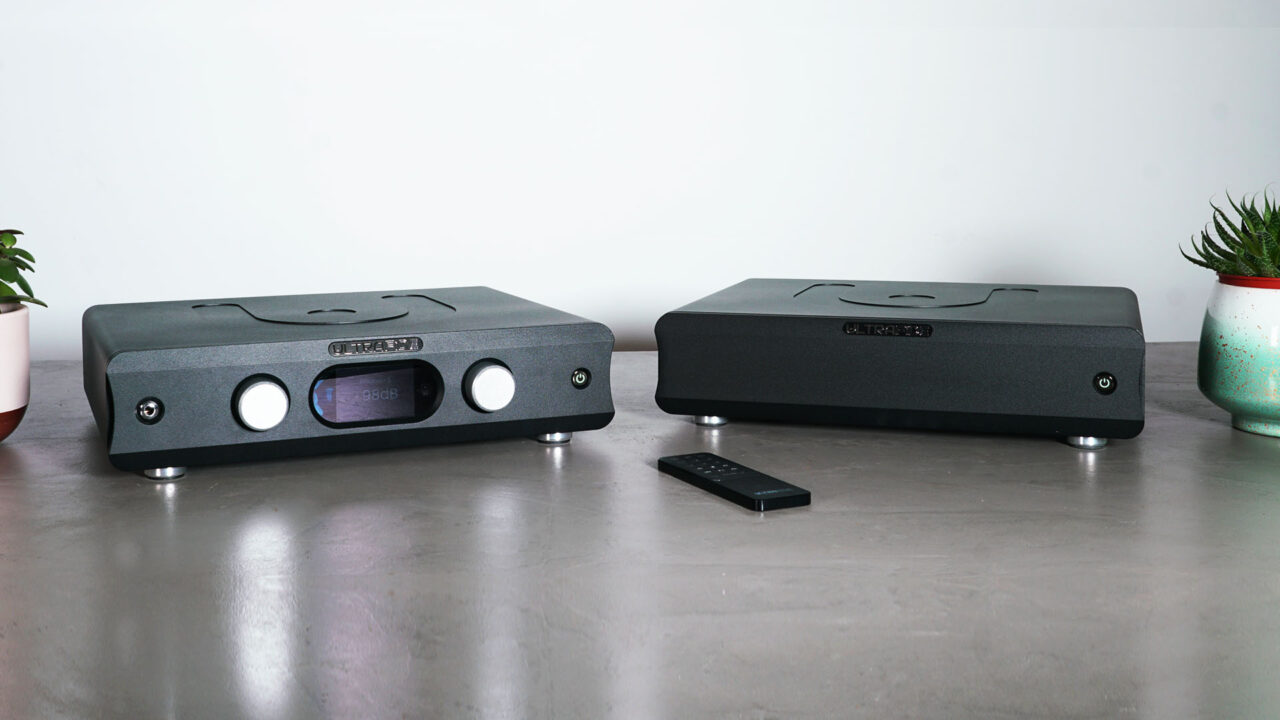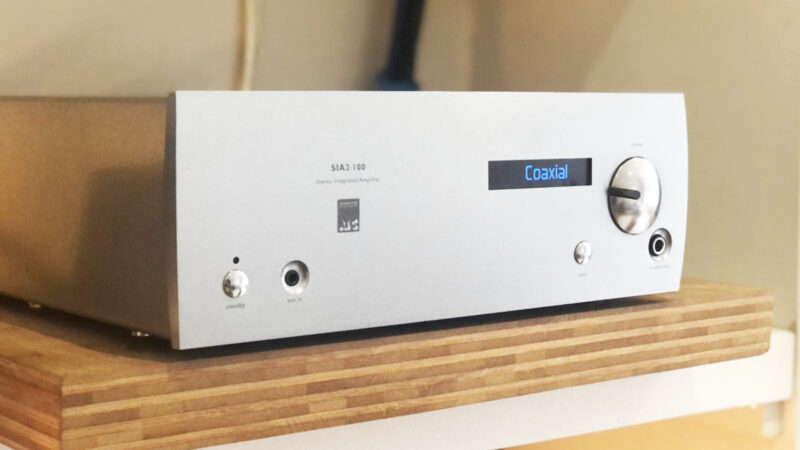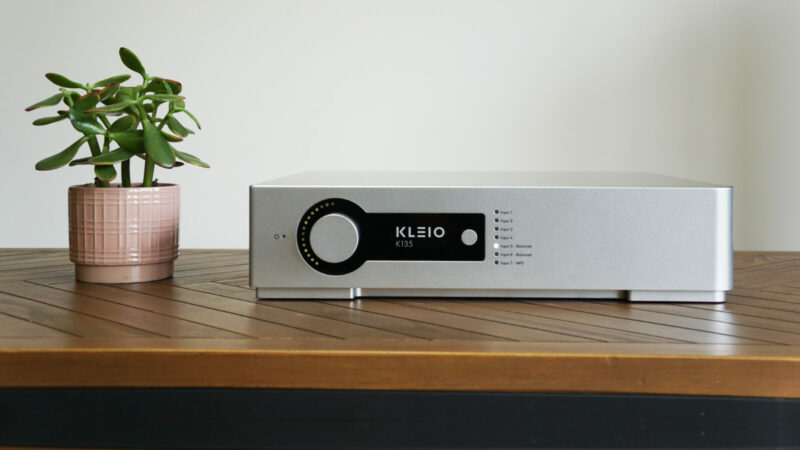If you’ve trodden the bustling corridors of the UK’s hifi shows this year, you’ll have noticed there’s been quite a buzz around Ultrafide Audio, with its rooms hosting busy demos to eager visitors, thanks to the sounds on offer.
Normally new brands exhibiting at these shows take a few years to find their professional stride, with enthusiasm tending to be a little ahead of the finished product. But not so with this company, whose debut products have a look and feel that suggests it has been at it for decades.
And in may ways it has, as Ultrafide is the hifi sister brand of Devon’s MC² Audio, which has been making pro audio gear for some three decades, establishing quite a reputation along the way. Its MC1250 was considered by many as one of the best-sounding pro audio amps on the market during its time, so venturing into home audio territory seems a logical next step.
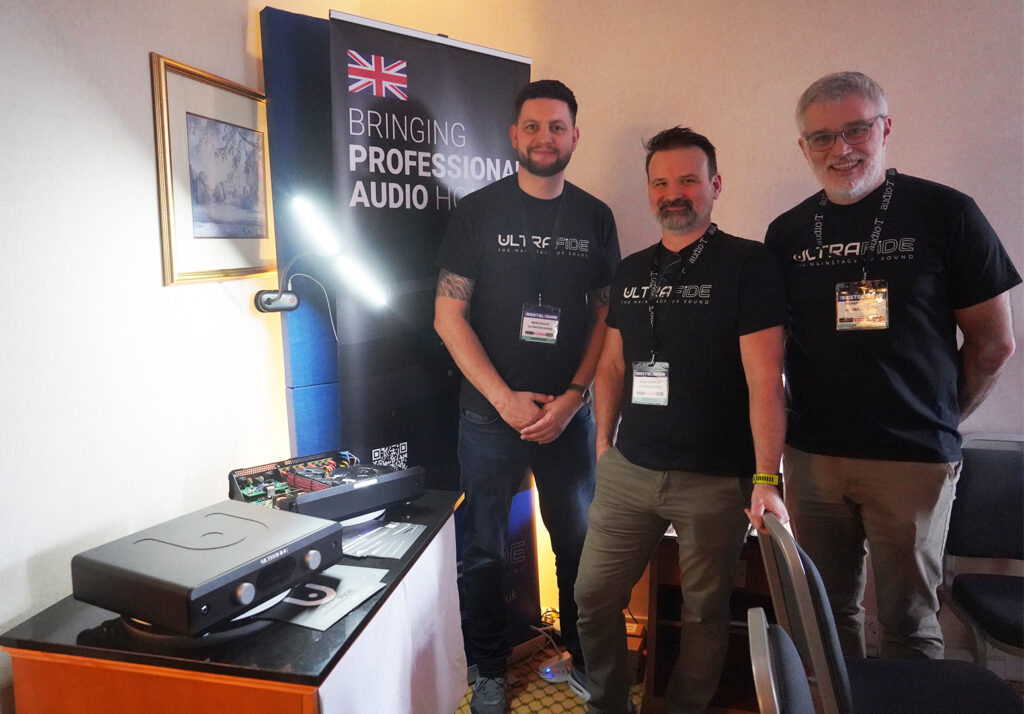
Team Ultrafide at this year’s Bristol Show
And that’s exactly what Ultrafide has done. But instead of dipping its debut toe with an integrated amp as many would to test the market (which is also cheaper to produce and ship, being one box), it’s started with two products at once as part of its Ultra Sigma range, in the guise of the matching U4PRE and U500DC pre/power amps at £4,500 each.
What this shows is a statement of intent, as right from the off it’s clear that this brand gets the sonic benefits of separating a preamp from its speaker driving partner for greater sonic gains.

U4PRE’s twin rotary dials cover input select (left) and volume (right). Note the heavy duty headphone socket (far left) and solid alloy remote that’s a cut above many rivals’ plastic types
Read more about MC2 and Ultrafide Audio’s history in our Spotlight On feature
U4PRE
The preamp is a Class A design, built around NJR bipolar op-amps. Attention has clearly been paid to its shielded linear power supply with its circuitry kept well away from the audio circuits, and with a claimed >111dB of dynamic range (unweighted) on offer.
While connections wise it’s analogue only, the spread it offers is a well thought out quality over quantity approach. You get two pairs of line-level (RCA) stereo inputs alongside two sets of balanced (XLR) sockets. There’s also a dedicated phono input for moving-magnet (MM) and moving-coil (MC) cartridge equipped turntables, with a range of settings via a bank of dip switches on its rear panel, with resistance on offer from 85-500 ohms in seven selectable steps for MCs, alongside 47 kohm for MM type pick-ups.
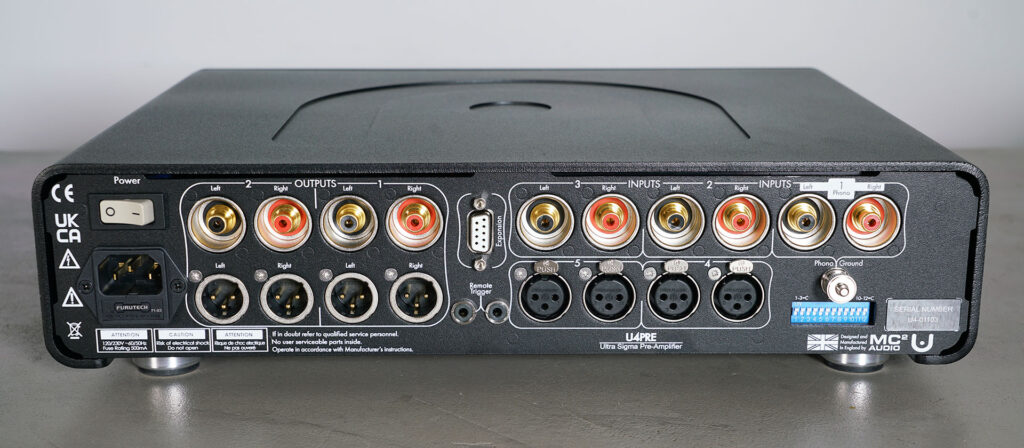
Rear socketry is top quality. Note the recessed RCA inputs for added protection. Single ended (RCA) and balanced (XLR) in/outputs are both catered for
Capacitance is also well served with eight selectable options spanning 100-470pF, while gain is even more finely tailored thanks to thirty 3dB steps from +35dB to +65dB.
Also adorning the spec sheet is a dedicated internal Class AB headphone amp, based around a dozen super low distortion discreet transistors with enough grunt and range to drive headphones from 8-300 ohms via a front panel 6.35mm output.

The blue bank of dip switches are for a wealth of phono stage settings (see Specification section), with both MM and MC bases covered
U500DC
The matching U500DC power amplifier is where things get even more interesting, as under its hood beats two of the brand’s own high speed push-pull Sigma-Delta Class D amps. Developed over three years, these feature separate dual power supplies plus an output stage with a single feedback loop. Its input drivers however are Class A, complemented by full DC coupling from input to output via direct copper tracks and wires.
On the power supply side a large bespoke 500VA shielded toroidal transformer gets the amp’s juices flowing with two 27,000uF storage capacitor banks, all of which combine to offer 250W into 8 ohm stereo channels, doubling to 500W into 4 ohms.
And perhaps as a nod to its pro audio heritage, Ultrafide has also added a degree of optional sound tailoring to the U500DC via a rear panel rocker switch offering ‘Pure’ and ‘Vintage’ tonal flavours. The former passes the signal through two 200V/35A, International Rectifier MOSFETs (per side) while the Vintage setting brings in three additional sets of matched pairs from Diodes Inc and Zetex (totalling eight transistors per side).

Boasting a blend of Class A and Class D internals, the U500DC isn’t your average hifi power amp
Nice package
Unboxing both amps and there’s no hint that you’re in the company of products that are new to market, quite the opposite in fact, starting right from the packaging that looks slick and professionally branded. In the flesh both amps sport nicely embossed top panels, curved cases without a screw head in sight and elegantly sculptured front panels, which means they can more than hold they own amongst more established hifi peers (although it would perhaps be nice if their side cheeks concaved to match the front panel curves at each end).
Where the Ultrafide units really excel though is in their build quality, because ‘tank like’ is not an understatement here. At only 380x100x295mm (WHD) for each unit’s case, with 5mm thick alloy all round (10mm thick for the front panel) and expertly recessed RCA sockets on the preamp’s rear, you can tell that these amps have been designed by a company that’s used to the rigours of pro audio life on the road. There’s a sense that they’d survive being thrown out of more hotel windows than Keith Moon’s telly without flinching, which means for domestic audio duties they feel reassuringly over-engineered.

U500DC power amp’s rear connections include two sets of multi-way loudspeaker sockets for bi-wiring alongside single-ended and balanced inputs. Note the Pure/Vintage rocker switch between the RCA sockets
Performance
Setting both amps up is nice and easy as everything is where it should be, feeling instantly accessible with plenty of space between each connection. Partnering kit is Primare streaming gear (NP30 network player and NP5 Prisma M2), an SME 20/2 turntable with AVID Nexus tonearm plus MoFi MasterTracker pick-up, and loudspeakers from Dynaudio (Evoke 50) and Wharfedale (the recently reviewed Heritage Dovedale grand standmount).
After swapping these amps in and out of my main system over a number of months, my longterm impression is how easy they are to live with, both practically and sonically. Elements like the preamp’s finely attenuated (with output shown in dB) volume control, the auto-dimming screen and how non-selected inputs within it are displayed in contrasting orange (only glowing white when selected) make the package feel intuitive and professional in use. Add to this that not only does the headphone jack auto-mute the speaker terminals when in use as you’d expect, a funky looking headphone emoji also pops up on the home screen to show that this circuit is in use, shows that nothing has been overlooked.
Another nice addition is the power amp’s tone switch which I was a little suspicious of at first, but after extensive A-B testing this has spent most of its time in my system in vintage mode for all out musical enjoyment.
Pure mode does exactly what it says, with everything sounding a little more evenly presented and forward in comparison (which in many ways makes this option more suited when using the amps as a reviewer’s tool). Pop the power amp in vintage mode and the mood gets a little more relaxed. Neil Young’s See The Sky About To Rain from 1974’s On The Beach at 24-bit/88kHz via Qobuz illustrates this perfectly, with Pure mode placing everything on an even playing field, from his vocals to the reverberating piano notes. It all sounds nice and clear and I’ve certainly no complaints, but flick the vintage switch and those vocals shift half a step back into the mix, while taking on a little more air and space around them, and the piano notes seem to hang in the air with a softer yet thicker texture, with both elements playing to the track’s stoned sounding vibe.
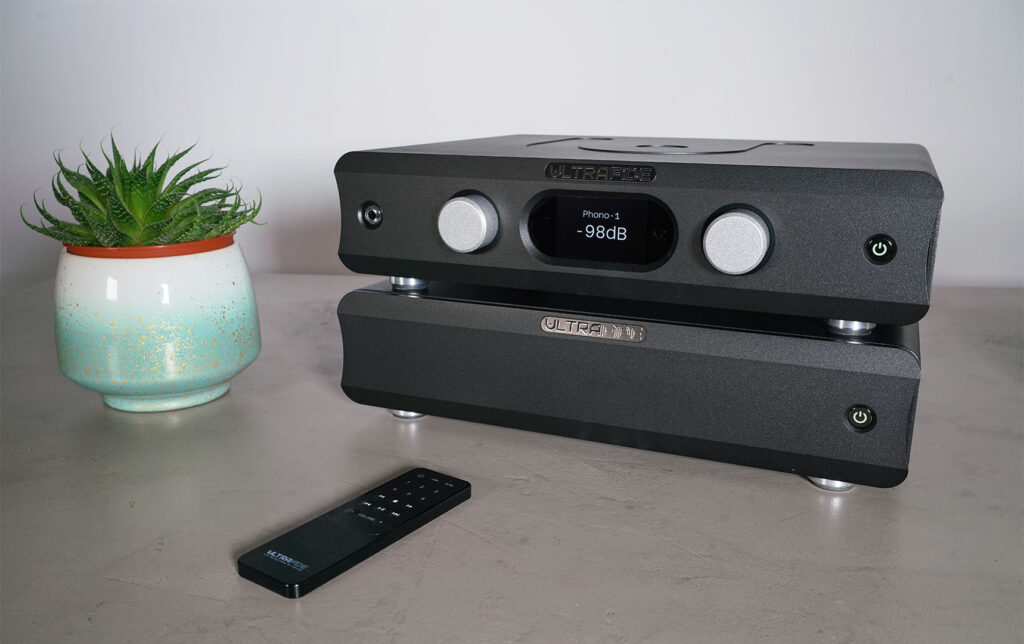
Measuring just 380x100x295mm (WHD), each amp is relatively compact
Double expresso
On other material though where I want a sonic performance that’s more sit-up and take notice, Pure mode is the one to go for. Depeche Mode’s Try Walking In My Shoes (at 16-bit/44kHz) for example isn’t a track that you want to nudge into chilled out territory, and Pure mode ensures its caffeine like pulsing energy is served up at full strength, with plenty of punch and bite across midrange and treble, adding impact to every detail. And while these amps do major on detail in a way you’d expect at this price point, it’s clear Ultrafide has voiced them to offer the right balance of studio like focus with a welcome measure of musicality thrown in, making them clean and clear sounding in their presentation yet dynamic and non-fatiguing in their delivery.
Another worthwhile inclusion is the preamp’s phono stage which can more than hold its own against standalone rivals well into mid-market territory (while offering more tailoring settings than many). Interpol’s 2002 benchmark LP Turn On The Bright Lights has convincingly vast levels of depth, separation and clarity with the SME feeding the U4PRE’s MM input. The rich echo and sustain of the opening guitar strums from NYC fall only marginally short of my reference Primare R35 for example, while the rumbling rhythm section has the right blend of dark – almost murky – tonality, without any hint of blurring or muddiness which many lesser rivals suffer on this track. In fact given how accomplished this input is, if Ultrafide followed up with a dedicated phono stage I wouldn’t be at all surprised.
The U4PRE’s headphone output is also worthy of praise. Driving a pair of Bowers & Wilkins Px8 cans and The War On Drugs’ Thinking of a Place at 24/44 has a delicious analogue mellow texture to the lower bass notes, although it’s not quite as velvety sounding compared to hearing the track through the Dynaudio or Wharfedale speakers, but this may also be attributed to how well both of these loudspeakers excel in soundstage and low end delivery, with neither speaker sounding shortchanged by the U500DC power amp.
In summary
Launching new brands into an industry that’s as well established as two-channel hifi takes courage and experience in equal measures, as you’re up against a buying public that typically tends to go with what it knows.
Thankfully Ultrafide isn’t as new to the party is it seems, with decades of audio knowhow behind it which these amps demonstrate. Both models have clearly been developed over time in a considered way, meaning what you get is a well thought out and finely executed package with a difference to set them apart from their rivals.
And given the quality of these products, I expect we’ll be seeing and hearing a lot more from Ultrafide Audio in the future.


